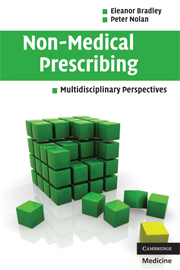Book contents
- Frontmatter
- Contents
- List of contributors
- Foreword
- Preface
- Acknowledgements
- Introduction
- 1 Medicines and prescribing – past and present
- 2 Nurse prescribing – impact, education and sustainability
- 3 Nurse prescribers: from 2003 to 2006
- 4 Nurse prescribing experienced
- 5 Nurse prescribing observed
- 6 Pharmacists and prescribing
- 7 Professions allied to medicine and prescribing
- 8 Conclusions
- Index
Foreword
Published online by Cambridge University Press: 22 August 2009
- Frontmatter
- Contents
- List of contributors
- Foreword
- Preface
- Acknowledgements
- Introduction
- 1 Medicines and prescribing – past and present
- 2 Nurse prescribing – impact, education and sustainability
- 3 Nurse prescribers: from 2003 to 2006
- 4 Nurse prescribing experienced
- 5 Nurse prescribing observed
- 6 Pharmacists and prescribing
- 7 Professions allied to medicine and prescribing
- 8 Conclusions
- Index
Summary
I would like to thank Prof Peter Nolan and Dr Eleanor Bradley at Staffordshire University for the chance to contribute this foreword. Staffordshire University was one of the very first universities to offer the former ‘Extended Formulary Nurse Prescribing’ postgraduate course, and the first Extended Formulary Nurse Prescribers [now Nurse Independent Prescribers] qualified from there. I oversee the Non-Medical Prescribing work programme at the Department of Health, so I was both interested and pleased to see Staffordshire's work.
The publication of this book is timely. We now have nearly 10,000 Nurse Independent Prescribers, and approaching 150 Pharmacist Independent Prescribers. There are 850 Pharmacist Supplementary prescribers; and the numbers of Allied Health Professional [AHP] Supplementary Prescribers – mainly physiotherapists and chiropodists/podiatrists – continue to grow steadily.
Extending prescribing responsibilities to nurses, pharmacists and other health professionals has not only improved patients' access to medicines; it also recognises the skills of senior and highly experienced professionals. Rigorous training and assessment processes help ensure that patient safety remains paramount and that prescribers are able to deliver effective patient care in a variety of settings.
There are now nurse and pharmacist prescribers in almost all areas of the NHS – from primary care, community setting, secondary and specialist care to palliative care. As the NHS moves away from hospital-based care and closer to the patient, non-medical prescribing provides an important mechanism to help deliver that care.
- Type
- Chapter
- Information
- Non-Medical PrescribingMultidisciplinary Perspectives, pp. xi - xiiPublisher: Cambridge University PressPrint publication year: 2008

